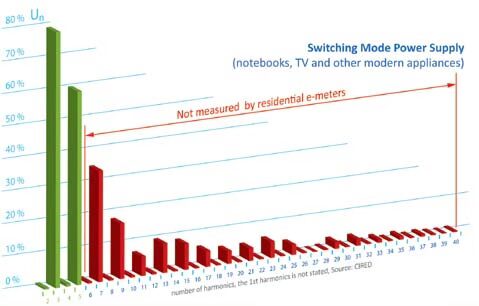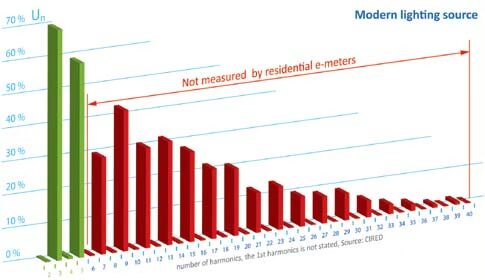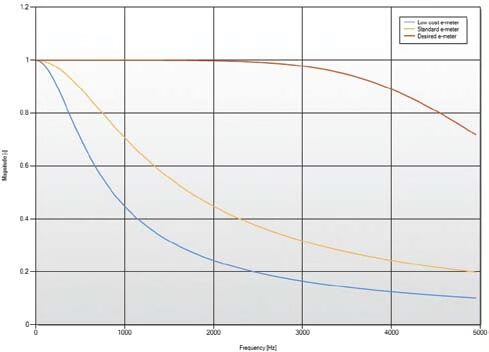New Measurement Standards: Higher Harmonics in the Grid
The situation on the low voltage grid has significantly changed over the past few years. This comes as a result of the arrival of new appliances – lights, electronics with switched-mode power supplies – and due to the changes at supply/generator sites.
Power Supplies – a lot of Small Players
In the past, big generators (rotating machines) were predominantly used. Their construction led to the direct generation of a sinus curve. Their distortion came as a result of technical (electric and mechanical) imperfections, and was very small.
Today, large amounts of small, non-rotating generators are in the field – they are switched-mode – inverters/converters. In order to generate pseudo sinusoid curves, pulse-width modulation (PWM) with low-pass filter is used. Modulation frequency reaches several kHz. Principally, PWM generates plenty of higher harmonics, which should be filtered from the final signal.
However, filtration of these harmonics brings higher financial costs, and it is thus, in most cases, tolerated. The higher power generated supplied, the more complicated and expensive the filtration (coil and capacitor) to be used. Subsequently, this leads to a power supply quality aggravation.
Appliances – No Reason for Satisfaction
In the past, household appliances operating on a resistance basis (bulbs, heating, water boilers…) prevailed. They consisted of simple regulators, their electronics were supplied from linear supplies. Rotating machines were controlled through classic linear regulators. Harmonics appeared very rarely, and were insignificant in size. Appliance were also well compensated at power factor.
That is why it was not necessary for final customers – households – to measure reactive energy or watch the power quality of supplied energy. This quality was monitored by big customers only, as well as at distribution transformers where it made sense to do so.

Today’s situation is quite different. Compact fluorescent lamps, and led bulbs prevail among light sources. They are supplied from switched-mode changers, and with poor compensation for power factor and none for disturbance.
Sometimes, the compensation is totally missing in order to keep prices low. Capacitors are used for limiting impedance for led bulbs. As a result, a decrease of active power consumption by tens of percent occurs while the influence of reactive, and higher frequency power, increases. We save on the active power, while the power factor is significantly deteriorated.

Nowadays, almost all appliances use switched-mode power supplies, or other synchronized changers controlled/switched-mode by zero crossing. These sources have relatively high efficiency and they are small in size, but if we use them, a large amount of higher current harmonics (and secondary to that, voltage) appears.
| Consumption (active power) | Apparent power | Power Factor | |
| Classic bulb | 60W | 60VA | 1 |
| Compact fluorescent lamp | 12W | 30VA | 0,4 |
| LED light | 5W | 10VA | 0,5 |
How E-meters (Don’t) Measure Higher Harmonics
E-meters (meters of power energy) should measure all delivered/consumed energy. It means both, energy of basic harmonics, and all harmonics that appear on the grid. Today’s electronic e-meters can measure with high accuracy very small amounts of current (stand by current).
On the other hand, they do not measure energy containing higher harmonics on the grid. At this stage, the legal measuring instruments significantly lag behind the real situation on the grid.
The most important limitation is the sample frequency of the analog digital converter (adc). This adc must be accompanied (according to sample theorem) with a low-pass filter – anti-aliasing filter-ensuring that higher harmonics will not approach the converter.
Today, the sample frequency normally reaches 1kHz – we can thus theoretically measure harmonics with frequency up to 500Hz (10th harmonic). Frequencies above 1kHz (the frequency for all power inverters) are not measured at all.
Frequency dependency of current transformers also has an (smaller) influence on results of higher harmonics energy measuring. This frequency dependency is badly compensated for in the time domain, while it can be compensated for in the frequency domain. Moreover, at two-core coils (with dc immunity), compensation is impossible.
E-meters with capacitor’s power supply also influence measuring of higher harmonics. These e-meters get hotter and warm up if higher harmonics are present. An E-meter’s supply is overloaded by higher harmonics, and, as a result, it can be damaged.

How Can We Manage It?
We have a couple of possibilities with regard to what approach we will choose in order to solve the problem of non-measurement of higher harmonics:
- We can leave this problem unsolved and behave like this is no problem. Perhaps in the hope that the situation will be better later?
- We can try better filtration at supplies. To force inverter producers to add quality filters, which means changes in relevant standards regarding quality of power supply, and EMC.
- We can try better filtration of appliances. The situation is the same as above, and concerns the implementation of another standard.
- By beginning to measure supply and load influence, and start to issue fines if the power factor is not kept. One of possibilities is to really measure all energy and measure power factor (PF). If PF is outside limits, the customers will pay more.
In any case, it is necessary to measure power in a wider frequency spectrum than is standard today (up to 10 kHz), and to monitor quality of power supply at more points within the grid.
Conclusion
Today, when the real consumption of appliances decreases, while reactive power grows and we have to add energy at higher frequencies, the current certified measuring devices are obsolete. The limits for additional errors and testing signals/curves must be changed.
Actual standards allow additional errors of up to 6% for harmonics measuring (lower harmonics). There is no standard for an e-meter to measure higher harmonics.
These standards for e-meters and quality of power supply DO NOT, however, reflect the fact that energy supplies and appliances have changed. It is thus high time to replace these standards with new ones.
